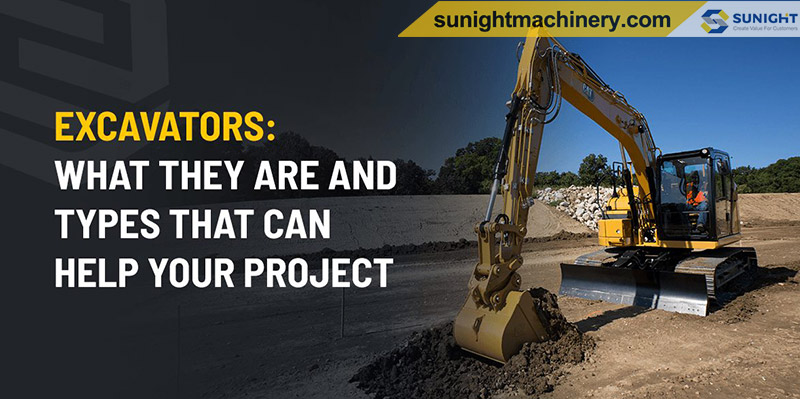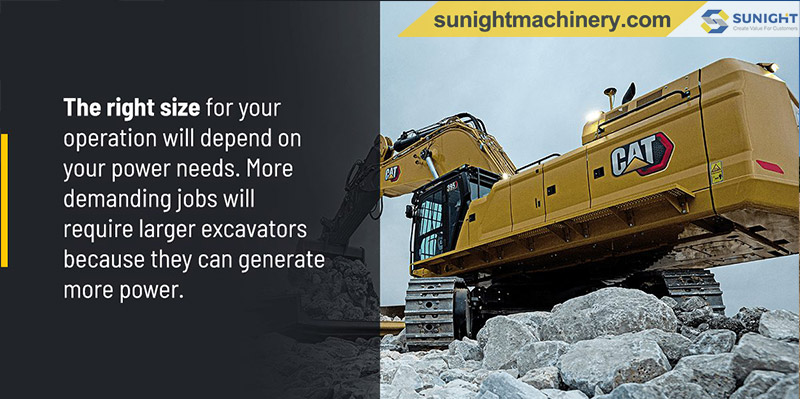Excavators are vital pieces of heavy equipment for applications across many industries, from construction to mining to landscaping.
This guide explains the different types of excavators and the many ways you can use them. We also cover how to decide which excavator is the right one for your operation. So if you’ve been considering investing in an excavator for your organization, read on to learn more.

WHAT IS AN EXCAVATOR?
Excavators, also known as diggers, are a type of heavy equipment often used for excavating or digging, as their name implies. They’re highly versatile, with applications in many different industries. An excavator has several key components:
- Boom: This is the angled arm that attaches directly to the excavator body. Knuckle booms can move in line with the machine laterally, while the standard boom can only move vertically.
- Dipper: Also called the stick, the dipper is the arm that extends from the boom and connects to the bucket or other attachment.
- Bucket: The bucket attaches to the end of the dipper. You can switch it out with other attachments whenever you need to use the machine for another application.
- Cab: The cab is the enclosed area that contains the machine controls and a space for the operator.
- Rotating house: The house contains the cab, engine, fuel tank, hydraulic tank and counterweights. Many excavator houses can rotate a full 360 degrees, which provides the operator with a high degree of mobility.
A wide variety of attachments are available for excavators, which allows you to take on different jobs. For example, you could swap the bucket for an auger for drilling operations or a rake for land-clearing projects.
WHAT IS AN EXCAVATOR USED FOR?
As we mentioned, excavators come in handy for many situations. Some common applications include:
- Landscaping: Thanks to their small size, mini excavators are especially useful for landscaping applications like breaking concrete, planting and uprooting trees and shrubs, building paths and even placing fence posts.
- Demolition: Excavators are extremely common on demo projects because they’re tough and efficient. You can use them for tearing down walls and clearing debris from a safe distance.
- Mining: Excavators are essential tools in mining operations because they clear soil from shafts and make it easy to extract the desired materials.
- Construction: You’ll see an excavator on almost every construction site. These excavators allow you to dig trenches and foundations easily, making them a staple piece of equipment in the construction industry.
- Material handling: The 360-degree rotation capacity of an excavator makes it excellent for lifting and moving building materials on any site.
- River dredging: Powerful dragline excavators are excellent choices for clearing silt and sediment from the bottoms of large bodies of water.
TYPES OF EXCAVATORS
There are many different types of excavators, defined by their size and configurations. Since the categories are relatively broad, it’s more helpful to focus on a specific factor when you’re evaluating which excavator you should choose. For example, if you need a smaller excavator for a landscaping job, it’s more efficient to look for one that’s 2 to 10 tons instead of just searching for a "mini" or "compact" model. That way, you can better account for the extra attachments and components you’ll need to complete your job.

There are four main size categories:
- Mini: Mini or compact excavators are the lightest and most mobile excavators available, making them the perfect choice for landscaping and urban operations. They can weigh anywhere from 2,000 pounds to just below 10 tons (20,000 pounds). Due to their lightweight frame and compact size, mini excavators leave a smaller footprint than models in other categories.
- Small: Small excavators weigh anywhere from 11 to 18 tons. They’re useful for light projects where you need a little more power than what a mini excavator can provide.
- Medium: Excavators that weigh between 20 tons to 35 tons fall into the medium-size category. Medium excavators are the most common type you’ll see, especially on construction sites. They come with high power demands, but that’s what allows them to have mighty digging capabilities.
- Large: These colossal machines weigh 36-90 tons. Due to their enormous size, they’re rarely used in uneven or urban environments. However, they provide high amounts of consistent power for intense lifting and bulk earthmoving projects. They’re also quite fuel-efficient, which can help you stay within budget even on large-scale projects.
The right size for your operation will depend on your power needs. More demanding jobs will require larger excavators because they can generate more power. Smaller, more delicate jobs need less power, so compact machines are the better choice.

